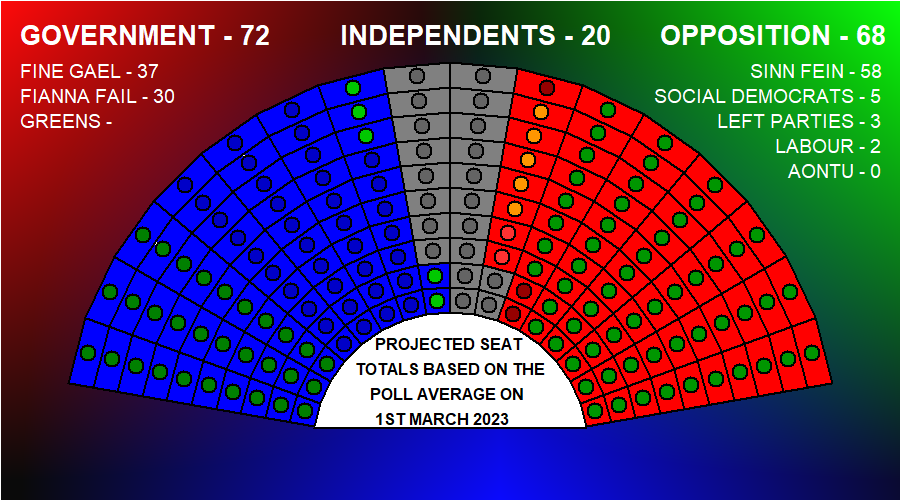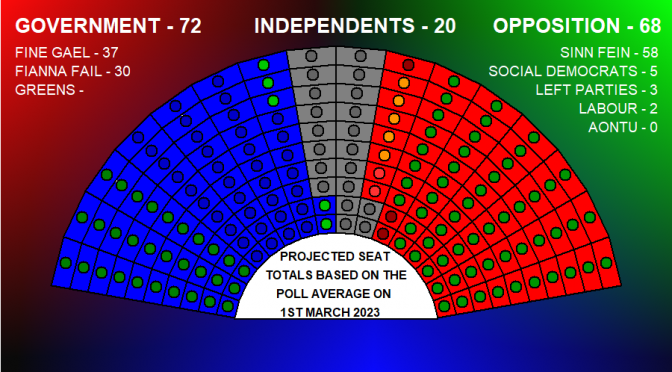I’ve done a time-weighted analysis of the last five Polls and using a Count Simulator have projected the outcomes as follows….
CONTENTS
Methodology
Dublin
Leinster
Munster
Connaught-Ulster
Government Formation
Demographics
Previous Poll Averages
Main Points
METHODOLOGY
The Country total and regional figures for each party/group are calculated using a time-weighted average from the last five poll. The Country Total is adjusted to ensure it is in line with the regional figures (some polls don’t issue regional data). The proportion each party loses (if anything) per region is then calculated. For instance if a party was at 18% and is now at 12%, it loses a third of its vote – if its vote was 24% in a constituency it falls to 16%, if it was 15% to 10% etc. Next it is determined what votes the gaining parties will receive – for instance Fianna Fáil votes might be (proportionately) more likely to go to Fine Gael than Sinn Féin etc. A simulation of a count in each constituency is processed – this uses transfer data from the 2020 General Election, and in 16 constituencies uses transfer data particular to that constituency (if we are looking at transfers based on 2020 transfer rates).
Also – in 2021 Sinn Féin received well over a quota worth of votes in many constituencies due to their only running one candidate (in Louth, Cavan-Monaghan and Donegal, they received well over two quotas with two candidates). In these constituencies, I’ve added a “dummy” 2nd SF candidate who takes one-third of the Sinn Fein vote.
It should be noted that these are merely the outcomes if regional swings were replicated in constituencies in that region. No attempt is made to factor in individual circumstances in each constituency.
PROVINCIAL BREAKDOWNS
DUBLIN
The Count Simulator suggests that Sinn Féin would gain six seats in Dublin – this is partialy due to their under-nomination of candidates last time which led to them missing out on likely second seats in Dublin Bay North, Dublin Central, Dublin South-Central and Dublin South-West. The rise in the Sinn Féin vote in Dublin is more muted than elsewhere in the country.
| 2 | 3 |
Fianna Fáil are forecast to lose five seats, Fine Gael perform marginally better in the capital than elsewhere in the country and would make a net gain of four seats – in fact they would only be two seats behind Sinn Féin. The Green party are forecast to win five seats down from eight in 2022.
In the most middle-class constituencies (Dublin Bay South, Dun Laoghaire and Dublin Rathdown), the Government parties would take 9 of the 11 seats; in the most working-class constituencies (Dublin South-Central, Dublin Nth-West and Dublin Mid-West) they would only take 3 of the 11.
| 1 | |||||||||
| FG | GP | ||||||||
| 1 | |||||||||
| 1 | |||||||||
| 1 | IND | S-P | |||||||
| 1 | 1 | ||||||||
| 1 | |||||||||
| 1 | 1 | ||||||||
| 1 | |||||||||
| 1 | 1 |
LEINSTER
The Count simulator forecasts that Sinn Féin would win three extra seats in Leinster.
| 1 | 5 |
Fianna Faíl would be forecast to make gains in Louth and Meath West, but lose seats in Longford-Westmeath and Laois-Offaly. The Green Party’s two TDs would also lose their seats. The 2 others are the sitting Social Democrat TDs.
.
| 1 | . | ||||||||
| 1 | |||||||||
| 1 | IND | FF | |||||||
| 1 | 1 | ||||||||
| 1 | 1 | FF | AON | ||||||
| 1 | 1 | ||||||||
MUNSTER
Opinion Polls have been suggesting a substantial rise in Sinn Féin support in Munster and accordingly the Count Simulator awards them seven gains.
The small parties all suffer with Labour losing both their seats and a similar fate befalling the Greens. Fianna Fáil would suffer a loss in Cork North-West to Sinn Féin – it was the only constituency Fianna Fáil took 2 out of 3 seats in 2020. It should be noted however – and this applies particularly to the two Labour seats – that seats particularly dependent on support in a defined rural area of a constituency are more impervious to national and regional trend.
| 1 | 1 | ||||||||
| 1 | 2 | 1 | SF,IND | FG,SP | |||||
| 2 | 1 | 1 | |||||||
| 1 | 1 | 1 | SF | FF | |||||
| 1 | 1 | 1 | SF | SD | |||||
| 1 | 1 | 1 | 2 | ||||||
| 1 | 1 | 2 | SF | GP | |||||
| 1 | 1 | 1 | |||||||
| 1 | 2 | 2 | SF | LAB | |||||
| 1 | 1 | 2 | FG,SF | GP,IND |
CONNAUGHT-ULSTER
There is significant change forecast in Connaught-Ulster with Sinn Féin gaining five seats to take 13 of the 29 on offer.
| 1 |
Fianna Fáil, Fine Gael and Independents would take 5 seats each.
| 1 | 1 | 3 | SF | FF | |||||
| 1 | 1 | 3 | SF | IND | |||||
| 1 | 1 | 1 | SF | FF | |||||
| 1 | 1 | 1 | 1 | 1 | SF | IND | |||
| 1 | 2 | ||||||||
| 1 | 1 | 2 | SF | FG | |||||
| 1 | 2 | 1 | SF | FG |
GOVERNMENT FORMATION
Neither the Government parties (72 seats) nor the Opposition Parties put together (68 seats) would reach the magic figure of 81 needed to secure a majority. The (technically) possible government formations would be : Sinn Féin and Fine Gael (95 seats); Sinn Féin and Fianna Fáil (88 seats) and also Fine Gael, Fianna Fáil,, the Greens, the Social Democrats, Labour and Solidarity-People Before Profit (82 seats)..

In other words, Sinn Féin’s only route to power on these numbers would be through coalition with Fine Gael or Fianna Fáil.
.PREVIOUS POLL AVERAGES
The table below shows the seat totals for previous poll analyses since the 2020 General Election.
Fianna Fáil dipped below 20 expected seats in the latter half of 2020, but have since recovered, and have remained at or above 30 seats since the end of 2021.
Every single analysis has suggested gains for Sinn Féin and they have made fairly consistent progress since the end of 2020. By contrast in the middle of 2020, Fine Gael were registering over 60 seats but have now fallen back to the mid-thirties.
| DATE | FG | FF | GP | GOV | SF | LAB | Others | OPP | IND |
| MAR 2020 | 47 | 30 | 6 | 83 | 58 | 3 | 5 | 66 | 11 |
| APR 2020 | 52 | 26 | 7 | 85 | 50 | 3 | 5 | 58 | 17 |
| MAY 2020 | 59 | 22 | 7 | 88 | 48 | 3 | 4 | 55 | 17 |
| JUL 2020 | 66 | 15 | 9 | 90 | 46 | 5 | 7 | 58 | 12 |
| AUG 2020 | 63 | 16 | 5 | 84 | 49 | 5 | 7 | 61 | 15 |
| JUN 2021 | 48 | 27 | 5 | 80 | 56 | 1 | 11 | 68 | 12 |
| SEP 2021 | 46 | 29 | 5 | 80 | 53 | 5 | 10 | 68 | 15 |
| OCT 2021 | 42 | 28 | 6 | 76 | 55 | 3 | 13 | 71 | 13 |
| NOV 2021 | 39 | 25 | 7 | 71 | 61 | 3 | 13 | 77 | 12 |
| DEC 2021 | 42 | 32 | 4 | 78 | 60 | 5 | 8 | 73 | 9 |
| MAR 2022 | 34 | 34 | 4 | 72 | 62 | 3 | 10 | 75 | 13 |
| APR 2022 | 38 | 37 | 4 | 79 | 59 | 4 | 11 | 74 | 7 |
| MAY 2022 | 38 | 32 | 4 | 74 | 66 | 3 | 8 | 77 | 9 |
| NOV 2022 | 38 | 32 | 3 | 73 | 66 | 2 | 10 | 78 | 9 |
| JAN 2023 | 40 | 31 | 4 | 75 | 63 | 2 | 4 | 69 | 16 |
| FEB 2023 | 35 | 33 | 2 | 70 | 61 | 4 | 9 | 74 | 16 |
| MAR 2023 | 37 | 30 | 5 | 72 | 58 | 2 | 8 | 68 | 20 |
The Government parties see a drop in numbers with gains for the Opposition. The last time the Government would have had enough seats for a majority was September 2021 – the opposition has not yet reached the magic figure of 80 and in fact are at their lowest level since September 2021.
MAIN POINTS
The current Government would not be returned on these numbers, although neither would any combination of the opposition parties.
Sinn Féin would make sweeping gains, mainly at the expense of smaller parties – though not to the same extent as previously. Their gains are more accentuated in the West of the Country as opposed to the East.
Fine Gael take 14 seats in Dublin to only 2 for Fianna Fáil. By contrast Fianna Fáil take 28 seats outside Dublin to only 23 for Fine Gael.
Regionally, the Fine Gael vote rises slightly in Dublin and Leinster whilst falling slightly in Munster and Connaught-Ulster. Sinn Féin’s vote rises in all regions.
